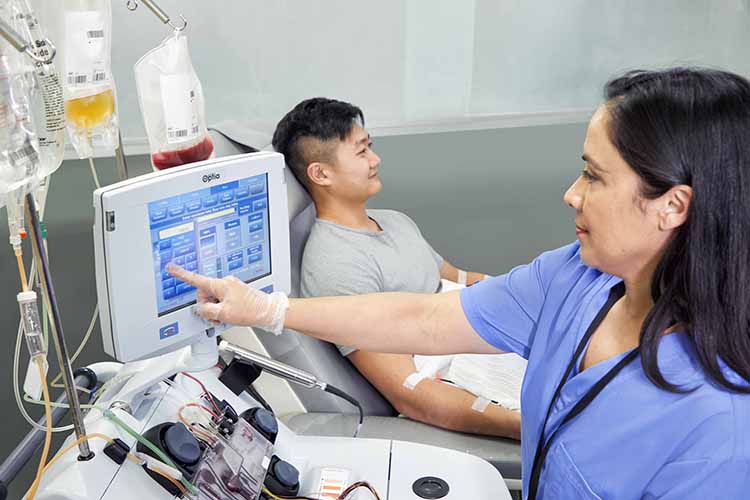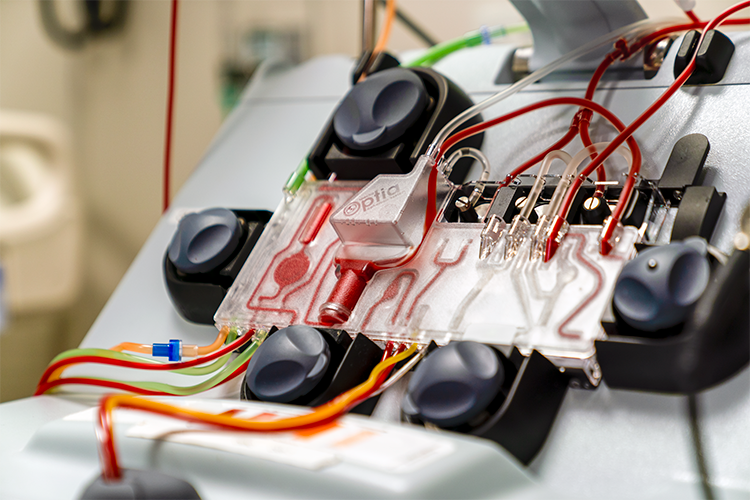|
|
|
Subscribe
|

|
|
Contact
|

|
|
Fall for improved outcomes: AC management best practices
Welcome to the latest edition of Access Point, a newsletter for those who regularly work with the Spectra Optia® Apheresis System from Terumo Blood and Cell Technologies. In this issue, we share best practices to help you manage anticoagulant (AC) during cell collection and exchange procedures.
As an apheresis professional, you know inadequate AC increases the possibility of platelet activation, formation of platelet clumps, microaggregates, and even clotting in the circuit. That makes properly configuring and adjusting the AC infusion rate (ACIR) and inlet:AC ratio critical to supporting safe, efficient, and successful outcomes. So let’s get started.
P.S. Don’t miss our informative customer spotlight below — featuring research on leveraging midline catheters in pediatrics.
|
|
|
|
|
|

|
AC adjustments that make a difference
With therapeutic plasma exchange (TPE) and red blood cell exchange (RBCX) procedures on Spectra Optia, you can configure the inlet:AC ratio and ACIR before starting the procedure.
Knowing how to adjust values during the procedure — based on the tolerance of the patient (for ACIR) or any observed clumping in the extracorporeal circuit (for inlet:AC ratio) — can make a difference in the outcome.
|
|
|

|
Collection configurations to support safer outcomes
When performing continuous mononuclear cell collection (CMNC) and mononuclear cell collection (MNC) procedures, properly configuring inlet:AC ratio and ACIR can be key to supporting safe, efficient outcomes.
You can configure inlet:AC ratio and ACIR before starting the procedure. You can then adjust if needed during the procedure based on the tolerance of the patient/donor (for ACIR) and flow of blood in the extracorporeal circuit (for inlet:AC ratio).
|
|
|
|
Dear Access Point,
Does Terumo Blood and Cell Technologies have a recommendation for using heparin on the Spectra Optia system?
— Melinda in Nashville, TN
Dear Melinda,
Terumo Blood and Cell Technologies does not recommend the use of heparin on Spectra Optia. The only validated anticoagulant is ACD-A. If you or your physician would like information about using heparin with Spectra Optia, please submit a Medical Information Request.
|
|
|
|
|
|
|
If you have a specific question about the Spectra Optia system, let us know. We’ll feature a reader question in each Access Point edition. Be sure to tell us your first name, hometown, and state or province. Questions not featured will be answered directly via email.
|
|
|
|
|
|
|
|
Managing the Symptoms of Hypocalcemia During Apheresis Procedures
Download this guide for more information on the prevention and management of hypocalcemia resulting from the use of citrate as an anticoagulant during apheresis procedures.
|
|
|
|
|
|
Just 1% of ionized calcium in the body circulates in plasma. The remaining calcium in the body is found in bones. Of the calcium in plasma, 47% is free, ionized calcium. This is the calcium that participates in primary and secondary hemostasis and is therefore the target of the anticoagulant used during apheresis.
Source: Terumo Blood and Cell Technologies. Anticoagulant Management on the Spectra Optia Apheresis System. Successions Training Presentation. 2021. Part number TS-OPTI-01182.
|
|
|
|

|
Improving access in pediatrics — midline catheters prove their worth
For apheresis professional Colleen Casacchia, BSN, RN, “Access is everything.” But Casacchia — Clinical Nurse Manager, Apheresis and Acute Dialysis, at California’s Children’s Hospital of Orange County (CHOC) — had growing concerns with the risks of central lines and the challenges of superficial peripheral vein access in pediatric apheresis procedures. She knew there had to be a better way.
Her literature research uncovered the idea of midline catheter use in adults, but there were no studies in children. Casacchia set out to change that — and her study’s results ultimately proved that this novel access method for pediatrics was not only a viable option, but in many cases, a better one.
In short, she says, “It’s completely changed our approach.”
|
|
|
|
|
|
Live and interactive sessions from our headquarters in Lakewood, Colorado
- IMUGARD WB PLT Platelet Pooling Set | December 7, 2023
If you are interested in attending one of these webinars, register here. If you would like a specific topic covered in one of these webinars, please send us an email.
|
|
|
|
November 2–4, 2023 | Minneapolis, MN
Hosted by National Marrow Donor Program/Be The Match
Upcoming Successions Programs: Red Blood Cell Exchange
November 8 and 9, 2023 | UT Southwestern Medical Center | Dallas, TX
If you are interested in attending the Successions workshop, please send us an email. Hurry, space is limited.
Are you interested in hosting or attending a future Successions workshop?
Contact your local Terumo Blood and Cell Technologies representative or send us an email.
|
|
|
|
|
|
You’re on the front lines of care, and we’re here to assist.
Contact us online or via 877.339.4228.
|
|
|
|
|